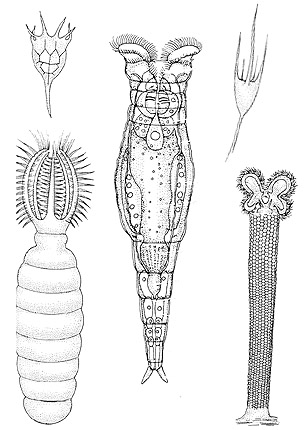
Where do we go from here.
We have explored successful clades (phyla) and followed evolutionary groupings.
1. Metazoa are monophyletic. So far we have looked at the basal phyla, Porifera, Cnidaria, Platyhelminthes. We have also explored some of the Lophotrochozoan and Deuterostome lineages. We have even explored some "problematical" lineages as the lophophorates. We are going to continue our examination adding clades to the lophotrochoan lines. Nematodes will be a pivotal clade because they introduce the cycloneuralia which are a smaller group among the ecdysozoans.
Nematodes (Nematoda) are a very successful and large group based on a simple body design. They are also part of a group know as Cycloneuralia (Nematomorpha, Priapulida, Kinorhyncha, and Loricifera) or groups with a circular brain or nerve ring around anterior digestive tract. Most cycloneuralia also have a pharynx and a hemocoel (pseudocoel) usually filled with cells, but still functions as hydrostatic skeleton to some extent. There usually is a well developed mouth, but a simplified head region. Cycloneuralia are also all Ecdysozoa. They therefore share some characteristics with Arthropods and their relatives. For these reasons they are considered more closely related to Arthropods than any other major clade.


But there are major groups that share characteristics with this "clade" whose taxonomic status is questionable, we will use Gastrotrichs as an example. Gastrotrichs like many cycloneuralians have a nerve ring around pharynx, a collagenous, non-cellular, external cuticle, and a tri-radiate pharynx. But unlike most cycloneuralians, gastrotrichs do not molt, do have locomotory cilia (covered with a cuticle sheath), and are hermaphroditic.

Another major grouping among basal spiralians involves the Rotifera and Acanthocephala. Rotifers are another amazingly successful group. They were once placed in a phylum Ashelminthes with nematodes and gastrotrichs. We will look upon them and their closely related sister group Acanthocephala. However, they are not Ecdysozoa and so their relationship to the Cycloneuralia and other Ecdysozoa is debatable.
